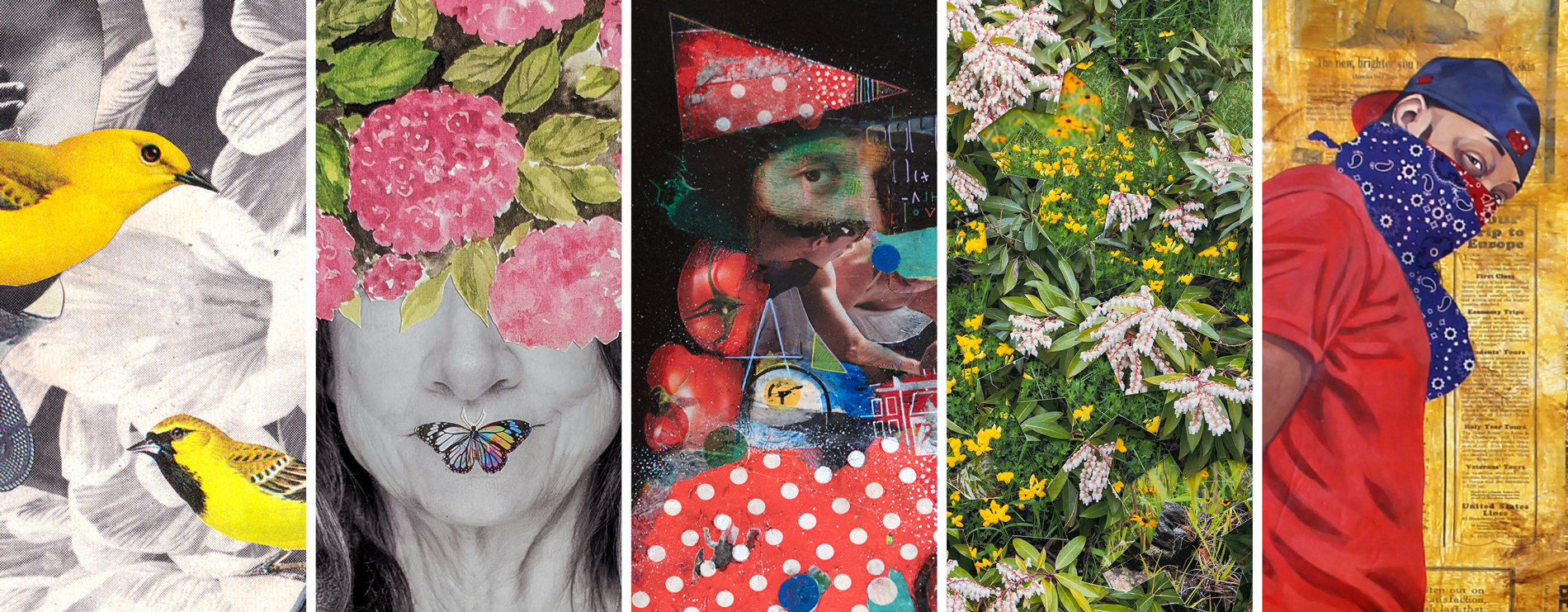
Kolaj is a quarterly, printed, 10″x8″ art magazine
featuring reviews and surveys of contemporary collage. The magazine takes an international perspective on collage as a medium, a genre, a community, and a 21st century art movement.
SUBSCRIBE OR ORDER A COPY
INSIDE THE ISSUE
Kolaj Magazine exists to report on the International Collage Community and how collage is making its way into the world. In this issue’s round-up of collage news, we report on the passing of venerable Oregon-based collage artist Eunice Parsons, who passed away in November 2024 at the age of 108. A collage from Kolaj Institute’s Artists in the Archive project by Burnaby, British Columbia collage artist Ginger Sedlarova was featured in a monograph about the Lazarus Family Legacy in Middlebury, Vermont. We report on a two-story collage mural in a Miami condo by Portland, Oregon collage artist Eva Lake and on a seed packet designed by New York-based artist Elizabeth Castaldo.
We review Freya Gowrley’s new history of collage, Fragmentary Forms. Gowrley wrote, “In this book, collage is neither a medium nor genre, but a mode; a means of processing the world as it was encountered by individuals across cultures and geographies.” In his review, Ric Kasini Kadour wrote, “The history of collage comes with a series of problems…Gowrley confronts this challenge head on and tackles it brilliantly.”
On the front cover of the magazine is Margarite by Carrie Ann Baade and inside the issue is an article about the Tallahassee, Florida artist’s exhibition at LeMieux Galleries in New Orleans, Louisiana. She wrote, “The genesis of this project stems from genealogical research on the French colonial presence in the Gulf Coast and American South, revealing a lineage of underrepresented women with Native American, Creole, and Romani origins. These women, each an essential thread in the region’s history, inspire a series of portraits that reimagine their lives through iconography and visual clues from their extraordinary experiences.” A collection of portraits, the artwork uses painting, collage, and assemblage to convey their story and make them seen.
The article “Girls of Summer” reflects on New Brunswick, New Jersey artist Alicia Saadi’s collage series using photographs of Newark from the Long, Hot Summer of 1967, a pivotal moment in the Civil Rights Movement. “Photographers provide powerful documentation of the world. Their work is important because they establish an objective reality, an inarguable truth about the world. Collage artists play a different role in culture: They help us make sense of that truth.”
In “A Place Called Home”, we consider how Rosie Schinners from Salt Spring Island, British Columbia used grief to make beauty. “I want to inspire hope or comfort or somehow counteract living in a really messed up world. I think beauty can be a good antidote and, for at least a short period of time, you can feel something good.”
Jennifer Evans reviews Suchitra Mattai’s collages at the National Museum of Women in the Arts in Washington, DC. She wrote, “I was struck by the beauty, the occasional use of contemporary images in these historical book pages, as well as ephemera not usually seen in two dimensional collage work—although it is something I often enthusiastically incorporate into my own collages; those rusty bits.”
We review Earmarked for Collision, seminal book about collage on screen by Ottawa, Ontario writer and author Chris Robinson, the Artistic Director of the Ottawa International Animation Festival and is a well-known figure in the animated film world. “Robinson’s deep understanding of the medium comes through in a way that unlocks deeper thinking about it.”
In a new feature, “Selections from the Collection”, we showcase artwork from the Kolaj Institute Collection that has been curated by participants in the Curating Collage Workshop. In this issue, Klee by Patti Robinson (Westhampton Beach, New York, USA) is curated by Alieneta Firdausi (Bantul, Yogyakarta, Indonesia). Aqui/Alla by Paola De la Calle (San Francisco, California, USA) is curated by Aurora Tower (Nashville, Tennessee, USA). Arrested by Jay Berrones (Mexico City, Mexico) is curated by Jamie Hughes (New Orleans, Louisiana, USA). Fronteras by Karla Rodriguez (Managua, Nicaragua) is curated by Bettina Homann (Berlin, Germany). Sleep, Sleep, Sleep by Ginger Sisco-Cook (Paris, Texas, USA) is curated by Phyllis Schwartz (Victoria, British Columbia, Canada).
And of course, the Kolaj Magazine Artist Directory.

ARTIST PORTFOLIOS
Each issue of Kolaj Magazine features portfolios of contemporary artists alongside critical commentary as a means of developing a deeper understanding of collage as both a medium and a genre. To be considered, register with the Kolaj Magazine Artist Directory at www.kolajmagazine.com.
Mayboll Vargas
San José, Costa Rica
“There is a profound need for healing within the female narrative of our history, and my art becomes a cathartic process through which I strive to honor these stories.” Daisy from Vargas’s “Cutting the Strings” series appears on the back cover.
Marian Tagliarino
Saint Petersburg, Florida, USA
“The collage reveals what I haven’t been willing or able to expose. Collage gives me the courage to express what lies within me.
Konstantine Patsios
Athens, Greece
“This materiality, and the alchemy of blending the humble and intangible, is my attempt to convey the emotional depth of human experience through fragmented images and a very personal narrative, which paradoxically resonates collectively.”
Gohar Dashti & Hamed Noori
Cambridge, Massachusetts, USA
“Through collage, we could visually express how landscapes, identities, and histories merge across borders, creating a conversation between different parts of our personal and shared journeys.”
Vitus Shell
Monroe, Louisiana, USA
“Collage is Hip-hop music. Remixing, reconstructing, reimagining, repurposing. It serves as the medium for the underresourced and the unheard.”
